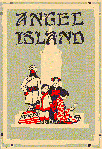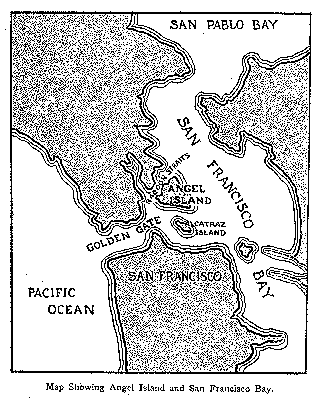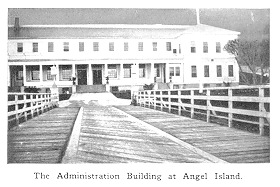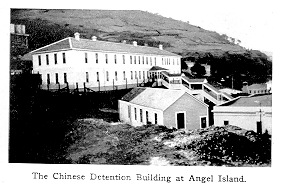


HTML format Copyright © 1998 Louis S. Alfano
All rights reserved.

ANGEL ISLAND


When a vessel bearing immigrants to California sails into San Francisco Bay, through the Golden Gate, anchorage is made at Meiggs' wharf, the vessel signals by whistling, and the immigration officials go aboard. The vessel proceeds to its dock in San Francisco, where first-cabin passengers land, but all others are sent to Angel Island, which corresponds to Ellis Island on the Eastern Coast.
To visit Angel Island, we must first obtain a pass from the Commissioner of Immigration. On visiting day, Tuesday or Friday, we go to Pier no. 7, San Francisco, to take the Angel Island Immigration Service boat, which makes several trips a day. We wait, toward the end of the long covered shed, for the coming boat. The cry of the sea-gulls is in the air, bells or whistles sound from different vessels, Chinese and Japanese wander about.
The Immaculate white boat for Angel Island comes alongside with its American, Japanese, and Chinese passengers. As they are discharged, the other Americans, Japanese and Chinese, who have been waiting, pass up the gangway and start on their Journey.
The Location -
If we go outside, on the narrow passage-way running around the cabin, the fresh salt wind smites
our faces as we look toward the Golden Gate. Between us and the Gate rises Alcatraz, the island
whose cannon guard the entrance to the Bay. The buildings on Alcatraz give the island
somewhat the shape of a man-of-war. For many years it has been used as a military prison.
Angel Island is a much better place to keep immigrants than the old detention-sheds in San Francisco were, as opportunities for coaching witnesses in fraudulent cases are now prevented by island isolation. Angel Island was first opened as an Immigrant Station in October, 1909. The next report of the Commissioner General of Immigration stated that the Angel Island Station had been built largely because the Chinese and their friends and attorneys had persistently complained that the conditions under which Chinese were detained in San Francisco were unsafe and unsanitary. But when these complainants discovered that the United States Government would have a great advantage in preventing the coaching of applicants and witnesses by occupying the Station at Angel Island, there arose violent protests, which, however, did not prevent the Government from carrying out its plan.
Angel Island is seven miles in circumference, and has an altitude of nine hundred feet. On the south side of the island, the buildings and the khaki-colored tents that we see, do not mark the Immigration Station portion of the island, but comprise what is sometimes called the "Casual Camp," where soldiers from the Philippines are lodged. On the west of the island, out of sight of our boat, is Fort McDowell, the military station. On the north side of the island is the quarantine station.

The Buildings -
Our boat passes a little further and turns by a wooded bluff. We swing alongside a wharf.
Connected with the wharf by a broad wooden walk, is the main building of the eighteen buildings
on this section of the island devoted to the United States Immigration Service. Ten acres of the
island are fenced in for this purpose. We pass up the walk to the Administration Building and at
the door we show our pass to the old doorkeeper. While we wait here for our guides, we notice
that this large room in which we stand is railed off into sections.
The Japanese -
The Japanese girls with the Japanese young men in one section are "picture-brides," with their
prospective bridegrooms and friends. Of the "picture-brides" I shall treat more fully in a later
chapter.
Our guide leads us from the main room of the Administration Building into a long curving passageway, wade secure by wire netting on the side opening outdoors, and we are ushered into the large dining-room for immigrants. Long, clean rows of tables stretch parallel to one another across the room.

The Chinese Detention Building -
Sometimes one may find here a group of little Chinese boys, eating with chopsticks. High above
the first table is a notice in Chinese, warning the Chinese not to make trouble, nor to spill food on
the floor. Off this dining-room, we pass into the fine kitchen that has cost many hundreds of
dollars. Everything is cooked by steam-heat. Two shining copper boilers are for the
ever-necessary tea of which the Oriental is so fond. The cooks are Chinese.
Passing back through the dining-room, we climb the long, broad stairway that leads up to the two-story Chinese Detention Building for the men. Sometimes there are two or three hundred men and boys up here. Some are mere boys of twelve or so, the sons of San Francisco Chinese merchants, or the alleged "sons," whose real status it is the perplexing task of the United States Government to determine. When we were in the main room of the Administration Building, we noticed that a railed-off section held a number of Chinese. They were witnesses, come to testify in some of the Chinese cases that are decided here.
Inside the Chinese Detention Building, near the door, are two electric switches. In case of a fore, pulling down one of these switches would cause a fire-escape ladder to slide from the upper story of the building to the ground. The other switch would alarm the people in the other buildings.
The young Chinese coming forward to see us are friendly. Our visit is a break in their day. Following our guide we pass small rooms till we enter a large room in which are about a hundred Chinese, most of them ranging in age from ten to twenty. Some of them are playing dominoes near the door. Rows of two tiers of sanitary wire beds run lengthwise through the room. Some of the Chinese boys are lying on the beds, reading, others are looking over their possessions. When the inmates realize that the visitor is giving away Gospels in Chinese, a small mob sometimes closes areond her, a good-natured mob, of course, and theyellow hands are thrust out for the Gospels faster than she can get them out of her bag.
Some of the immigrants are being treated at the white hospital on the bluff opposite the Detention Building.
The Deportation of Chinese Women -
An immigrant examination involves of necessity the deportation of those who are adjudged unfit
to enter the country. It is a sad sight to see the poor creatures who have come so far turned back
at the very door. I will remember one very unhappy occasion. I had brought a party of women
with me to see the island, and had secured the unusual privilege of admission to the rooms where
the Chinese women are detained.
As we approached these rooms we heard the strange confused sound of many voices. Ceaseless, opposing, it was the wailing protest of the Chinese women against the deportation of three of their compatriots. Presently the three women passed us on their way to the boat which was to take them to the Mongolia sailing that day for the Orient. Poor souls! They looked as though they had cried their hearts out.
Usually deportation means that the Chinese women are taken to Hongkong, where they fall almost immediately into the hands of slave-dealers, who take them back to the old dreadful life. The Methodist deaconess formerly at Angel Island vainly tried to learn of some one at Hongkong who would undertake to look after the Chinese women deported from the United States and protect them from their former masters. If California is to be kept clean in some measure, such poor slave women must probably be deported, but could not two such great nations as the United States, which sends the women back, and England, ruling at Hongkong, make some arrangement whereby the slave-dealers at the port would be prevented from capturing these women?
The United States has a plan under consideration concerning women and girls of European countries depaorte from this country. At the Quinquennialmeeting of the International Council of Women, held at Rome, Italy, in May, 1914, Mrs. Kate Waller Barrett, special agent of theUnited States Immigration Service, endeavored to secure the endorsement and assistance ofthe international Council of Women toward the establishment in each country of groups of representative persons who would correspond directly with the United States Government and would assume the care and protection of deported girls or women from their respective countries, until such time as these girls or women were "capable of self-direction." Would that some such plan might be carried out for the deported Chinese women reaching Hongkong!
The Indians -
Our guide takes us to the other side of the building to show us the Hindus. Here they come!
Fine-looking, stalwart fellows, with white turbans swathing their heads, they come up the long
stairway and confront us. Other Indians are in the farther room. How different this type of men
from the Chinese or Japanese whom we have been seeing! Some authorities hold that the Hindu
and the American both belong to the Aryan race, and that whether we like it or not, these Hindus
are bone of our bone. Our speech bewrayeth us, according to the philologists. One looks back
through the ages, and sees the time when the Aryan forefathers of these Hindus, and our own
forefathers, parted in central Asia, the Hindu forefathers going south, and in a subsequent
emigration, our forefathers going west. The Hindu is not a Mongolian, but our long-lost brother,
and the Californian is not usually any more glad to see him coming than the respectable brother
was to see the prodigal son in the parable. I recall seeing a small group of indians beside the
entrance to the Pacific mail Steamship Company's pier in San Francisco, before the sailing of a
steamer, and hearing a white man adjure the harmless group, who were not obstructingf anything
I could see, "You move on! You fellows can't stand there talking!"
Those Indians were not devoid of human instinct when treated kindly, for when I gave a copy of the Gospel of john written, in the strange oval and horizontal Punjabi characters, to one of the Hindu of the group, he drew a nickel from his pocket as if to pay me, and on my refusal, he uttered an "Ah-h!" of protest. Another time, after I had given a group of four Indians some Gospels in Punjabi, one of them who wore a red turban came after me and held out his sallow hand in whichwas a little change, as if he would have paid me. When I refused the money he thanked me.
The kindly hearted American who pleasantly says, "Salaam," in greeting an Indian, hears "Salaam," in return. A missionary from India, while visiting the camps of Indians in northern California, was gladly received when it was discovered that he could speak Hindustani. Once on his way to an Indian camp, the same missionary saw a workman in a field and called to him in his own tongue. The man came running and was full of joy at being spoken to in his native language. His employer called him, but he enthusiastically shouted back, "I can't work now! My brother has come! My brother has come!"
A San Francisco employee of the American Bible Society told me of a friend who had carried gospels to an outgoing steamer, and an Indian was so glad to receive a gospel in his native tongue that he kissed the book. A colporteur is said to have found five Indian laborers at prayer one evening in their hut. Not a word of English could any of them speak, but they were readsing from a bible that a missionary had given to one of them in India, and which he had brought with him to America.
The Koreans -
Another and very interesting oriental race to be found in California, although in small numbers,
is the Korean. As very few of them are now coming to this country, I have never seen them at
Angel Island. I have often met them, however, in my work, and shall give a description of them
in a subsequent chapter.


To get in touch with me send e-mail to
Lou Alfano.
Be
sure to include your full name, as I will NOT reply to
unsigned e-mails.
Please do not write from AOL or Compuserve addresses, because these
ISPs BLOCK e-mail from ".it" domains.
